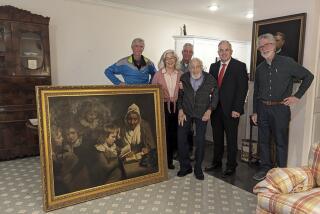LAW : Art Objections: A Citizen Sues Over Wyeth Sale : A South Carolina artist is fighting a county museum’s loss of 26 paintings to a Japanese store chain.
GREENVILLE, S.C. — Don Owens says all he wants is the 26 Andrew Wyeth paintings back in the Greenville County Museum of Art, and he’ll fight anyone, anywhere to get them.
He’s already taken his case to the state Supreme Court, battling the Greenville County Council, the museum, its director, Tom Styron, and the multimillionaire who bought the paintings and let them be displayed at the museum.
“I feel like it’s time to put up or shut up,” said Owens, 53, a self-employed graphic artist. “A lot of people complain about government, but nobody’s willing to do anything about it.”
At issue is whether Arthur Magill, who made a fortune in textiles and is one of Greenville’s most generous arts patrons, gave the works to the museum or simply lent them.
Magill and museum officials say it was simply a long-term loan and that he had every right to take the paintings from the museum two years ago and sell them for $45 million to Seibu-Pisa Ltd., a Japanese department store chain.
Magill bought the paintings from movie producer Joseph E. Levine in 1979 for $3.5 million. Accompanying the bill of sale was a letter from Levine that the sale was being made with the understanding that the artwork would be displayed at the Greenville County Museum of Art.
Owens said that letter is key to the dispute, but so far, he hasn’t had much luck making his case. A lower court threw out his lawsuit, saying Owens had no right to sue. The high court’s decision on whether the suit can proceed is due this summer. Owens filed the suit as a county resident who claims county officials failed to preserve prized assets.
In the past decade, Greenville has traveled the hard road from cotton mill town to Yuppie haven. In that time, the arts world here has blossomed, with the formation of numerous theater groups and art associations--many of which got their seed money from Magill--and the recent construction of a $40-million performing arts center. The Wyeth paintings were considered a major triumph.
Magill, who headed Her Majesty Industries Inc., a children’s clothing manufacturer, until he sold it in 1976, has been involved in just about every arts endeavor in this city of 60,000 people. He gave half of the $1.5 million to build the art museum in 1974.
He said recently that he bought the Levine collection because “it seemed a quick way to get the museum on the map.”
For 11 years the paintings did just that, but, according to friends, Magill grew increasingly dissatisfied with the management of the museum, including the director who preceded Styron, and the commission that oversees its operation.
“As early as 1980, it had become public knowledge that Magill was not going to give those paintings to the museum,” said Styron.
Then in early 1990, Seibu-Pisa representatives made Magill an offer, which he told Styron about. In April, Magill had Styron sign an agreement that he would keep details of the negotiations secret. One paragraph in the six-page agreement stated that the paintings were on loan to the museum and that the museum had no ownership rights.
Owens especially wants to see Magill’s tax returns to determine if he took deductions for donating the paintings to the museum.
Magill’s attorney said he has refused to give the returns to Owens because he has no right to sue.
Magill had planned to give the museum $6 million of the money from the sale but has held off on $5 million of it until the lawsuit is settled.
Styron said not having that money has hurt acquisitions, especially since the art market has been depressed and some fine examples of Southern art--the museum’s focus--have slipped away.
“The facts are that Arthur Magill bought the paintings and loaned them to us, and they were never the property of the museum,” Styron said.
Counters Owens: “When the museum had those Wyeths, they had something really special. I have no personal animosity against Mr. Magill. I just think those paintings belong to the museum and I’m doing what any good citizen should.”
More to Read
The biggest entertainment stories
Get our big stories about Hollywood, film, television, music, arts, culture and more right in your inbox as soon as they publish.
You may occasionally receive promotional content from the Los Angeles Times.










